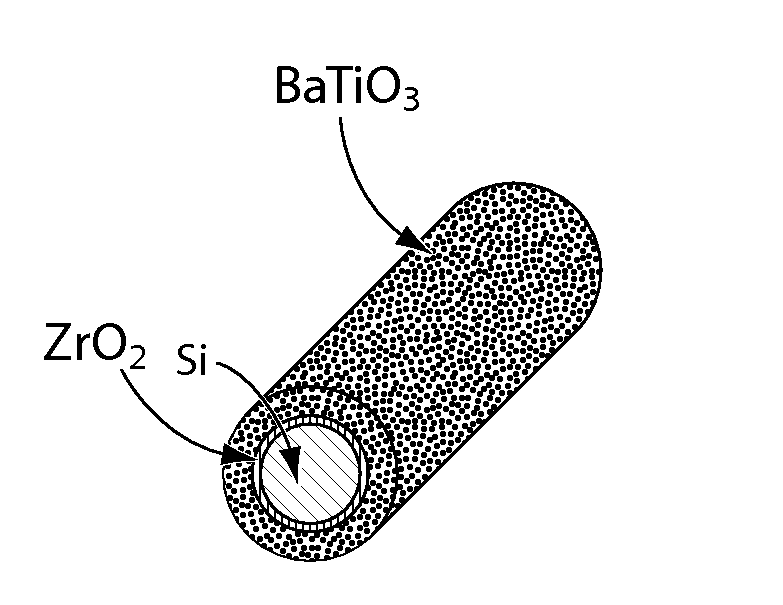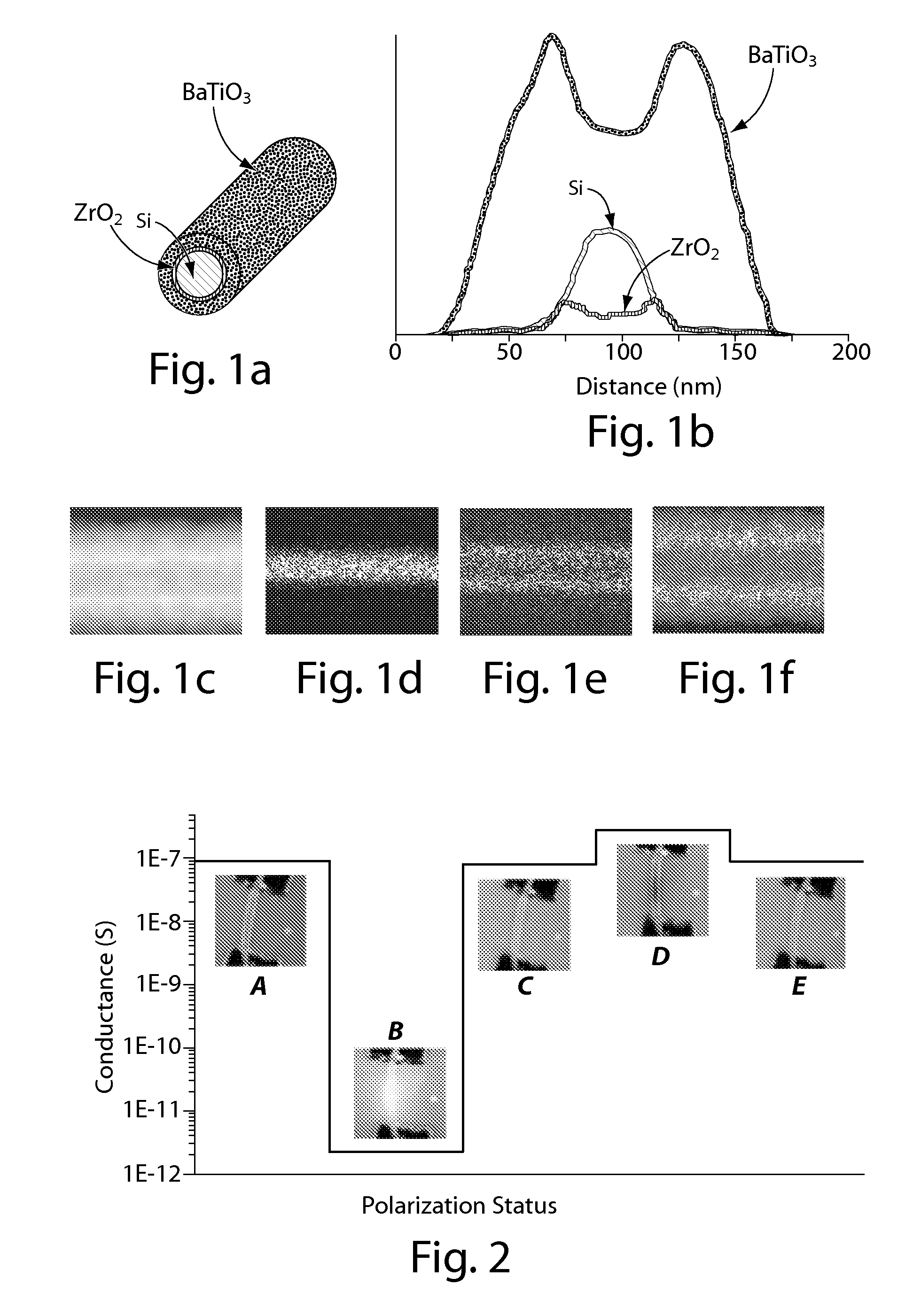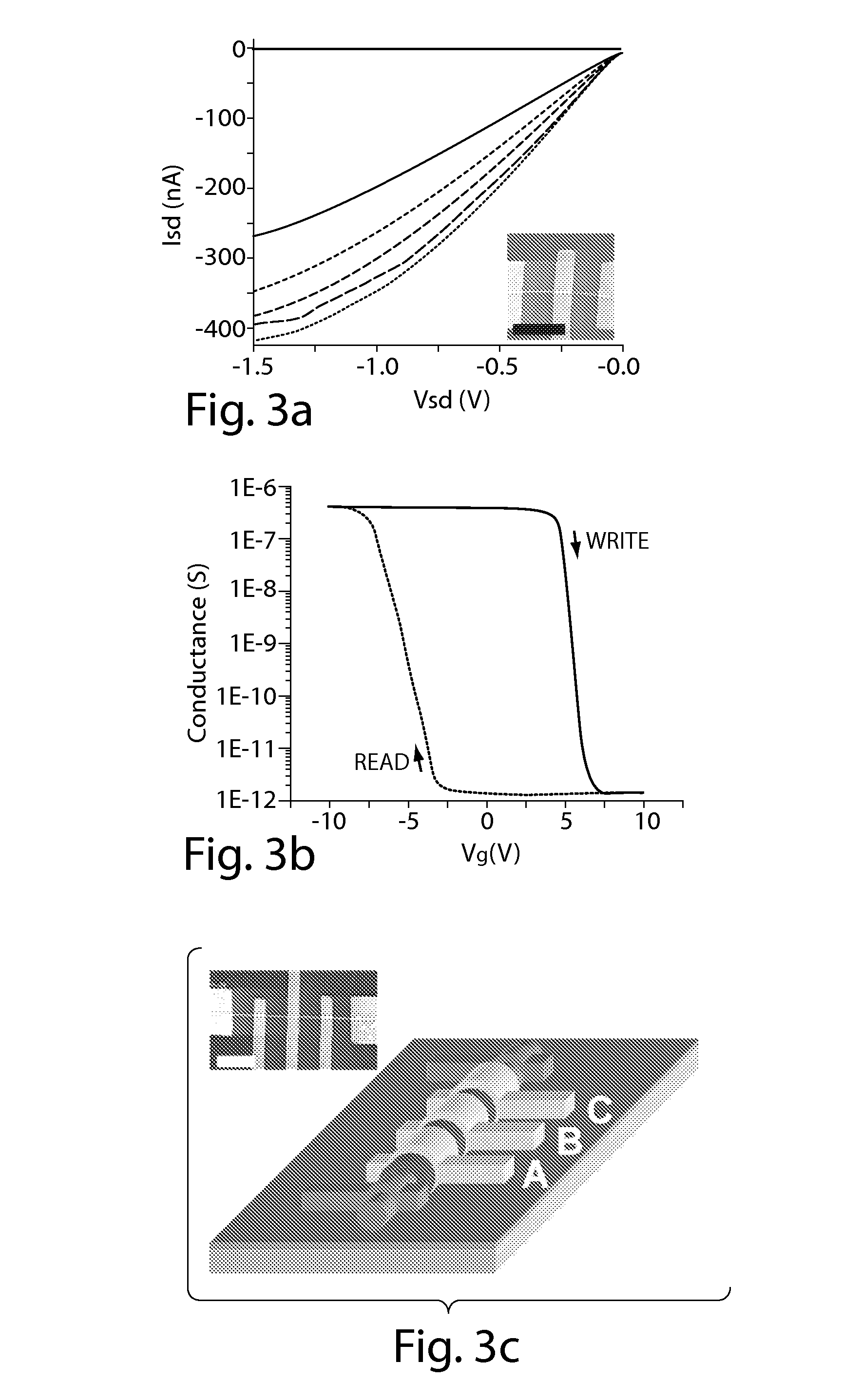Nanoscale wire-based data storage
a data storage and nano-scale technology, applied in the field of nanotechnology and sub-microelectronic devices, can solve the problems of undeveloped nanotechnology and nanoelectronics
- Summary
- Abstract
- Description
- Claims
- Application Information
AI Technical Summary
Problems solved by technology
Method used
Image
Examples
example 1
[0110]This example demonstrates the synthesis of semiconductor / dielectric oxide / ferroelectric oxide core / shell / shell nanoscale wire structure, specifically p-Si / ZrO2 / BaTiO3 core / shell / shell nanoscale wires (FIG. 1A), according to one embodiment of the invention. In this example, the shells were fabricated using ALD techniques (atomic layer deposition), but other techniques, for example, solution-based approaches, can be used as well.
[0111]The synthesis starts from chemical vapor deposition growth of p-type silicon nanoscale wires using gold colloids as a catalyst, silane as a reactant, and diborane as a dopant in the well-known VLS growth process. After growth, the growth wafer was transferred directly into an atomic layer deposition reactor. ZrO2 high-K dielectric oxide was deposited onto the Si nanoscale wires to make p-Si / ZrO2 core / shell nanoscale wires by using ZrCl4 as a Zr source and water vapor as an oxygen source. ZrO2 can function as a high-K dielectric, which can enhance p...
example 2
[0120]This example illustrates the fabrication of silicon-functional oxide core-shell nanowire heterostructures by atomic layer deposition (ALD), in which the conformal coating of various materials, including oxides, on silicon nanowires was achieved through cycled self-limiting surface reactions by alternating pulse and purge cycles for different reactants. The thickness of the coating was controlled by the number of deposition cycles down to the atomic scale, and thus, the technique may be suitable for fabricating multi-compositional heterostructures with clean interfaces.
[0121]One of the example structures synthesized was a silicon (Si)-zirconium oxide (ZrO2)-barium titanate (BaTiO3) semiconductor-dielectric oxide-ferroelectric oxide core-shell-shell nanowire heterostructure (FIG. 12). FIG. 12A shows the deposition of functional oxide shells over p-type silicon nanowires. The synthesis started from the growth of p-type Si nanowires by chemical vapor deposition, followed by vapor ...
example 3
[0127]This example illustrates the synthesis of a well-defined semiconductor-functional oxide core-shell nanowire heterostructure with a clean interface. In this example, a field-effect transistor (FET) device was prepared based on a Si / ZrO2 / BaTiO3 core-shell nanowire heterostructure (FIG. 14). To form the device, the oxides at the source-drain regions were etched away by hydrogen fluoride (HF) acid, followed by deposition of metal contacts on the p-type Si core. A nickel top gate was fabricated between the source-drain contacts on top of the BaTiO3 shell (inset, FIG. 14A, which is a SEM image showing the device geometry, and source-drain contacts having 3 micrometer separation on the p-type Si nanowire core and an 800 nm wide top gate on the top of the BaTiO3 shell in the middle of the channel). The scale bar in the inset is 2 micrometers. Transport results of current (Isd) versus source-drain voltage (Vsd) data (FIG. 14A) at different gate voltages (Vgs) obtained from a core-shell...
PUM
 Login to View More
Login to View More Abstract
Description
Claims
Application Information
 Login to View More
Login to View More - R&D
- Intellectual Property
- Life Sciences
- Materials
- Tech Scout
- Unparalleled Data Quality
- Higher Quality Content
- 60% Fewer Hallucinations
Browse by: Latest US Patents, China's latest patents, Technical Efficacy Thesaurus, Application Domain, Technology Topic, Popular Technical Reports.
© 2025 PatSnap. All rights reserved.Legal|Privacy policy|Modern Slavery Act Transparency Statement|Sitemap|About US| Contact US: help@patsnap.com



